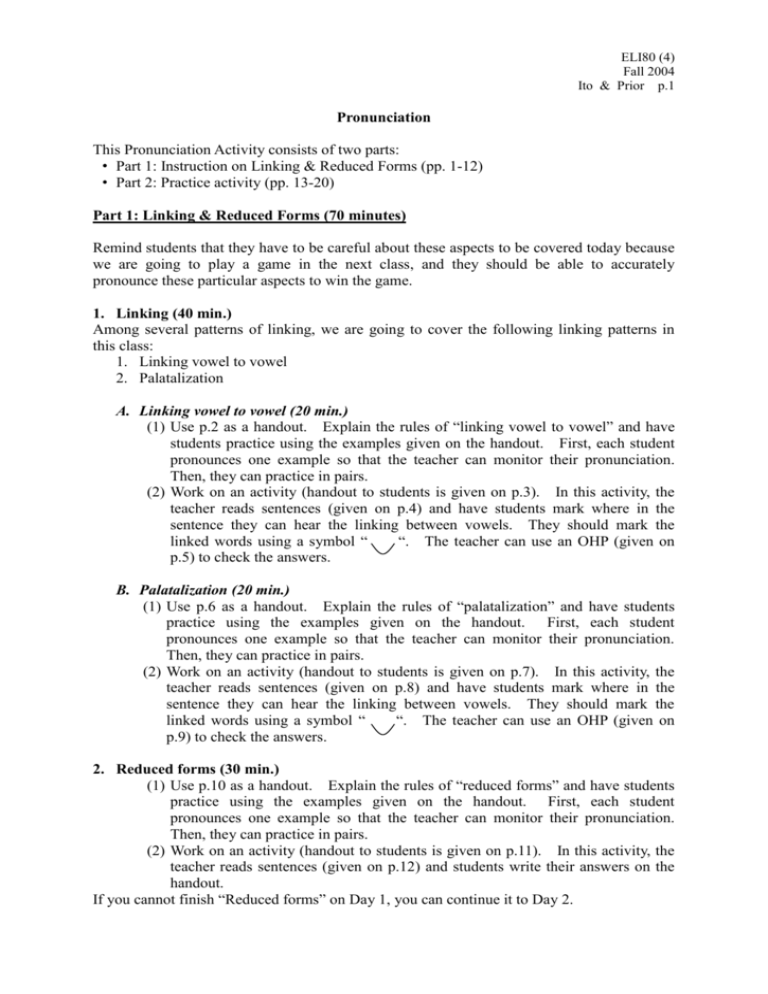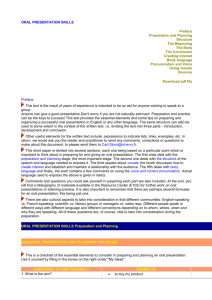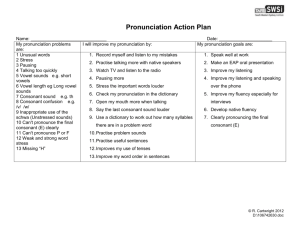Pronunciation Instruction
advertisement

ELI80 (4) Fall 2004 Ito & Prior p.1 Pronunciation This Pronunciation Activity consists of two parts: • Part 1: Instruction on Linking & Reduced Forms (pp. 1-12) • Part 2: Practice activity (pp. 13-20) Part 1: Linking & Reduced Forms (70 minutes) Remind students that they have to be careful about these aspects to be covered today because we are going to play a game in the next class, and they should be able to accurately pronounce these particular aspects to win the game. 1. Linking (40 min.) Among several patterns of linking, we are going to cover the following linking patterns in this class: 1. Linking vowel to vowel 2. Palatalization A. Linking vowel to vowel (20 min.) (1) Use p.2 as a handout. Explain the rules of “linking vowel to vowel” and have students practice using the examples given on the handout. First, each student pronounces one example so that the teacher can monitor their pronunciation. Then, they can practice in pairs. (2) Work on an activity (handout to students is given on p.3). In this activity, the teacher reads sentences (given on p.4) and have students mark where in the sentence they can hear the linking between vowels. They should mark the linked words using a symbol “ “. The teacher can use an OHP (given on p.5) to check the answers. B. Palatalization (20 min.) (1) Use p.6 as a handout. Explain the rules of “palatalization” and have students practice using the examples given on the handout. First, each student pronounces one example so that the teacher can monitor their pronunciation. Then, they can practice in pairs. (2) Work on an activity (handout to students is given on p.7). In this activity, the teacher reads sentences (given on p.8) and have students mark where in the sentence they can hear the linking between vowels. They should mark the linked words using a symbol “ “. The teacher can use an OHP (given on p.9) to check the answers. 2. Reduced forms (30 min.) (1) Use p.10 as a handout. Explain the rules of “reduced forms” and have students practice using the examples given on the handout. First, each student pronounces one example so that the teacher can monitor their pronunciation. Then, they can practice in pairs. (2) Work on an activity (handout to students is given on p.11). In this activity, the teacher reads sentences (given on p.12) and students write their answers on the handout. If you cannot finish “Reduced forms” on Day 1, you can continue it to Day 2. ELI80 (4) Fall 2004 Ito & Prior p.2 Linking Vowel to Vowel Source: Celce-Murcia, M., Brinton, D. M., & Goodwin, J. M. (1996). Teaching pronunciation: A reference for teachers of English to speakers of other languages. New York: Cambridge University Press. Rule 1: When a word ending in //, //, //, or // is followed by another word beginning with a vowel, the two words are connected by a // glide: // // // // + vowel Examples Be a sport. Play Tie = // glide a game. it up. Employ a professional. Rule 2: When a word ending in //, //, or // is followed by another word beginning with a vowel, the two words are connected by a // glide: // // // + vowel = // glide Examples through it all slow and steady How are you? ELI80 (4) Fall 2004 Ito & Prior p.3 Listening Activity —Linking Vowel to Vowel— Listen to the teacher’s pronunciation and mark the place where two vowels are linked. There may be more than one position in one sentence where sounds are linked. Example Be a sport. through it all Linking with // glide 1. Do you know the answer? 2. I didn’t say it. 3. Where is the office? 4. May I ask? 5. I always tie it. Linking with // glide 6. I didn’t go into the water. 7. Her blue eyes are beautiful. 8. Do I know her? 9. I didn’t go out last night. 10. There are two apples. ELI80 (4) Fall 2004 Ito & Prior p.4 Listening Activity —Linking Vowel to Vowel— Answer key for teacher Linking with // glide 1. Do you know the 2. I didn’t say it. 3. Where is the 4. May 5. I answer? I office? ask? always tie it. Linking with // glide 6. I didn’t go 7. Her blue 8. Do into the water. eyes are beautiful. I know the boy? 9. I didn’t go 10. There are two out last night. apples. ELI80 (4) Fall 2004 Ito & Prior p.5 Linking with // glide 1. Do you know 2. I say didn’t 3. Where 4. May 5. I the answer? it. is the I office? ask? always tie it. Linking with // glide 6. I didn’t 7. Her blue 8. Do I 9. I go into eyes the are water. beautiful. know her? didn’t 10. There are go out last two apples. night. ELI80 (4) Fall 2004 Ito & Prior p.6 Palatalization Source: Celce-Murcia, M., Brinton, D. M., & Goodwin, J. M. (1996). Teaching pronunciation: A reference for teachers of English to speakers of other languages. New York: Cambridge University Press. Rule 1: When the consonants // are followed by // in an unstressed syllable, the two sounds combine to form a palatalized consonant: Alveolar consonant Palatalized form Pass // + // // // + // // Example your plate. Where’s your fork? Why didn’t // + // // Eat your vegetables. Where did // + // // Hide you? you go? your spoon. ELI80 (4) Fall 2004 Ito & Prior p.7 Listening Activity —Palatalization— Listen to the teacher’s pronunciation and mark the place where two consonants combine to form a palatalized consonant. Example Pass your plate. 1. We’ll miss your sweet smile. 2. You’ll freeze your toes. 3. Is that your dog? 4. She needs your help. 5. What did you eat last night? ELI80 (4) Fall 2004 Ito & Prior p.8 Listening Activity —Palatalization— Answer key for teacher 1. We’ll miss 2. You’ll freeze 3. Is that your toes. your dog? 4. She needs 5. What did your sweet smile. your help. you eat last night? ELI80 (4) Fall 2004 Ito & Prior p.9 1. We’ll miss 2. You’ll 3. Is your freeze your that your 4. She 5. What sweet needs toes. dog? your did you smile. help. eat last night? ELI80 (4) Fall 2004 Ito & Prior p.10 Reduced Forms ESL learners often complain that “native speakers talk too fast!” It is partly because students are not familiar with so-called reduced forms in spoken English. Reduced forms involve unstressed vowels, omitted sounds, linking, and so on. Using reduced forms is normal English: it is not sloppy or “incorrect.” Being familiar with reduced forms can (i) greatly improve your rhythm in spoken English, and (ii) improve your listening comprehension skill. Content words vs. Function words • Content words: nouns, verbs, adjectives, adverbs (Remember the discussion we had about “key words” in preparing a note for your presentation!) • Function words—These become reduced forms in spoken English. Reduced forms Examples Tell him. Pronouns him // // Leave her alone. her / / // Where did you go? you // // Give them a book. them // // I can wait. Auxiliary verbs can // // It has been very helpful. has // // You should have told me. have // // I will do it. will // // Articles (e.g., a, the, some), prepositions (e.g., at, for, from, of), and conjunctions (e.g., and, as, or, than, but) are also function words, and therefore become reduced forms. Full forms (as opposed to reduced forms) are used in the negative, at the end of a sentence, and when they are used as main verbs instead of auxiliaries. Examples They can’t wait. Yes, I have. He has a problem. / // // References Celce-Murcia, M., Brinton, D. M., & Goodwin, J. M. (1996). Teaching pronunciation: A reference for teachers of English to speakers of other languages. New York: Cambridge University Press. Dauer, R. M. (1993). Accurate English: A complete course in pronunciation. Englewood Cliffs, NJ: Prentice Hall Regents. Gilbert, J. (1995). Pronunciation practice as an aid to listening comprehension. In D. J. Mendelsohn & J. Rubin (Eds.), A guide for the teaching of second language listening (pp. 97-112). San Diego, CA: Dominie Press. ELI80 (4) Fall 2004 Ito & Prior p.11 Listening Activity —Reduced Forms— Listen to the teacher’s pronunciation and identify whether the teacher said can or can’t. Circle the happy face for can and the unhappy face for can’t. 1. 2. 3. 4. 5. 6. ELI80 (4) Fall 2004 Ito & Prior p.12 Listening Activity —Reduced Forms— Answer key for teacher 1. You can park here. 2. You can speak Spanish. 3. They can’t come. 4. They can swim. 5. He can’t fix the car. 6. She can’t play the guitar. ELI80 (4) Fall 2004 Ito & Prior p.13 Part 2: Practice activity (30-40 minutes.) Objectives 1. Let students practice the aspects of pronunciation covered in class, as well as pronunciation in general (speaking). 2. Let students pay close attention to particular aspects of pronunciation covered in class (listening). Directions Students get into groups of 4 people (i.e., 4 groups in total). One person (Speaker) comes to front and get a sentence from the teacher. The sentence contains one aspect that was covered in the previous pronunciation instruction (linking and reduced forms). Their task is to accurately pronounce that particular aspect to their own group members. The group members’ (Listeners’) task is to (i) listen to the Speaker’s pronunciation, (ii) write down the whole sentence word by word, (iii) identify what aspect of pronunciation the speaker is trying to accurately pronounce among different aspects covered in class, and (iv) mark it properly on the sentence. Here is an example: Sentence to be read: We’ll miss your sweet smile. 1) Speaker goes to front and teacher shows a card like the following to the Speaker. We’ll miss your sweet smile. 2) The Speaker remembers this sentence and goes back to his/her group. He/she should pronounce the sentence that he/she got, with a linking between miss and your, inserting a // sound. He/she should also pronounce the whole sentence accurately so that the Listeners (i.e., his/her own group members) can correctly write down every single word on a sheet of paper. 3) Listeners write down every single word on a sheet of paper. After writing down the entire sentence, they should also mark what aspect the Speaker is particularly careful about in pronunciation, among the aspects that were covered in class. In this example, the Speaker should be careful about the linking between miss and your. Therefore, Listeners should correctly mark the linking on the sentence. The written answer should look as follows. We’ll miss your sweet smile. 4) Listeners might also mark on other aspects, e.g., reduced forms, because they were also covered in class. Then, their written answers might look as follows. (Forms that are reduced will be underlined in this activity.) We’ll miss your sweet smile. ELI80 (4) Fall 2004 Ito & Prior p.14 Even though this is the case, as long as the Listeners marked the target aspect in this example (linking between miss and your) correctly, they get a point. 5) Once they are done with one sentence, the next Speaker (different person) in the group goes to front and repeat the same process. 6) The answers should match as a group. In order to do it, they should compare their answers within their groups. The Speaker should not tell the answers! We can repeat this four times, i.e., every member in each group should have at least one chance to pronounce a given sentence to his/her group members. The answers should match as a group. In order to do it, they should compare their answers within their groups. The Speaker should not tell the answers! Once they got all the four sentences written down, they should bring the paper to the teacher and show it to him/her, and the teacher checks if the group got all sentences as well as the target pronunciation aspects correctly. The group that got all the answers most quickly and perfectly gets reward (maybe Halloween candies?). If time allows, we can continue for the second round. During the process, the other teacher will monitor the students so that they won’t cheat (e.g., tell them where should be marked verbally, without actually trying to pronounce them)! Here are the rules in this game: (1) The symbols that are used to mark the particular aspect of pronunciation are as follows: Linking: “ “ between two words e.g., We’ll miss your sweet smile. Reduced forms: underlining forms that are reduced e.g., We’ll miss your sweet smile. (2) It is OK to mark other aspects if the Listeners think those aspects were also pronounced accurately. As long as they get the target aspect correctly, they get points! (3) Listeners can ask the Speaker to repeat as many times as they want. (4) Speaker should not tell the answer to the Listeners when comparing the answers among Listeners. (5) Speaker should not tell the answer verbally without actually trying to pronounce the target aspect (e.g., bad to tell the Listeners that “linking is between miss and your”). Directions for teacher 1. Explain the procedure, using an example. See pp.16-17 for an OHP to be used to explain the procedure. 2. Divide the students into groups of 4 people (i.e., 4 people in each group). 3. Have them decide the order of Speaker within their own group. 4. Begin the game. ELI80 (4) Fall 2004 Ito & Prior p.15 5. Show Speakers from each group a target sentence. 6. When one group brings an answer, check the answers to see if the group got all the sentences correctly written down (every single word) and got the target pronunciation aspects correctly marked. The actual sentences that we are going to use are given on pp. 18-20. After the activity finishes, it would be a good idea to review all the sentences that they just read in this activity as a whole class. For this purpose, I would encourage teacher to prepare OHP sheets of pp. 18-20. ELI80 (4) Fall 2004 Ito & Prior p.16 1. Get into small groups and decide the order of Speaker. 2. Game begins! The first Speaker of each group comes to front & see a card like these: We’ll miss your sweet We’ll miss your sweet smile. smile. 3. The Speaker should memorize the sentence, word by word, as well as the particular pronunciation aspect that should be carefully pronounced—linking or reduced forms. 4. Go back to your own group and tell your group members (Listeners) the sentence that you memorized. You should (1) clearly pronounce the whole sentence accurately, and (2) carefully pronounce the target aspect (linking or reduced forms) to the Listeners of your group. 5. The Listeners should write down the entire sentence, word by word, and mark the particular pronunciation aspect that the Speaker seems to be especially careful about. The written answer might look like this: We’ll miss your sweet smile. 6. Once all the Listeners write down the answer, the next Speaker comes to front and gets the next sentence from the teacher. 7. Repeat the process until you get all the 4 sentences. When you get all the 4 sentences written down, compare your answers within your group and come up with an agreed answer. When you do it, the Speaker should NOT tell the answer! ELI80 (4) Fall 2004 Ito & Prior p.17 Rules (1) The symbols used to mark the particular aspect of pronunciation are as follows: Linking: “ “ between two words e.g., We’ll miss your sweet smile. Reduced forms: underlining forms that are reduced e.g., We’ll miss your sweet smile. (2) It is OK to mark other aspects if the Listeners think those aspects were also pronounced accurately. As long as they get the target aspect correctly, they get points! (3) Listeners can ask the Speaker to repeat as many times as they want. (4) Speaker should not tell the answer to the Listeners when comparing the answers among Listeners. (5) Speaker should not tell the answer verbally without actually trying to pronounce the target aspect (e.g., bad to tell the Listeners that “linking is between miss and your”). ELI80 (4) Fall 2004 Ito & Prior p.18 Round 1 1. 2. 3. The student must have forgotten the homework. Sorry, but we aren’t coming to your party. Which country are you going to travel to this winter? 4. Have you read your mail yet today? ELI80 (4) Fall 2004 Ito & Prior p.19 Round 2 1. I called him yesterday to discuss our homework. 2. 4. I’d like to meet your family in New York. 3. out to eat last night? Did you go He went to see it with his classmates. ELI80 (4) Fall 2004 Ito & Prior p.20 Round 3 1. 2. I thought you took ELI 70 last semester. Didn’t you say that he was going to Africa next month? 3. 4. I should have done it much earlier. She can solve the problem by herself.







